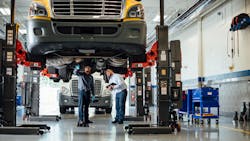Procurement strategies: A focus on asset utilization and maintenance
Editor's note: This is the second part of a two-part series on vehicle procurement strategies in today's challenging environment. Read part one here.
In an environment where the semiconductor shortage is expected to linger well into fall, and material shortages are accompanied by a spike in costs—which are running at record highs—for steel, lumber, aluminum, rubber, and plastic, properly maintaining assets is more important than ever. Claude Ricciardi, the national director of purchasing for Transervice, stresses the importance that fleets pay particular attention to preventive maintenance (PM) schedules to keep their equipment running longer than they may have anticipated.
Gino Fontana, Transervice’s chief operating officer and executive vice president, also pointed out that utilization of equipment, which might often be overlooked, is critical to keep an eye on in today’s volatile market. Depending on the location, Transervice customers typically have equipment that is more heavily utilized compared to other assets, Fontana noted. That, he said, puts higher demand on that higher utilized piece of equipment, which racks up more miles and PM intervals, and tires, brakes and other components wear out faster.
Fontana advised fleets to look across their network of equipment and balance that utilization by putting equal loads across all equipment rather than “beating the daylights out of” certain pieces of equipment while other assets sit idle.
When it comes to utilization, Brian Holland, president and CFO of Fleet Advantage, couldn't agree more. He also emphasized the importance of maximizing the utilization of an asset and thoroughly understanding the different specs needed for distinct duty cycles and geographical areas.
“Utilization is important,” Holland told FleetOwner. “Instead of just focusing on one component of the operation, we look at a lot of different metrics and the optimal point of when fleets should be cycling out the asset.”
Holland added that, in general, fleets are also putting greater emphasis on shorter PM intervals to help mitigate the rising cost of maintenance. “Maintenance is not only costly, but it also impacts driver satisfaction when equipment is down,” Holland said.
Less-than-truckload and dedicated carrier A. Duie Pyle has made it a point to tailor its maintenance programs to each vehicle manufacturer and factors in the duty cycle to schedule equipment for PM inspections.
“You never want to just cut and paste the same spec year after year,” Dan Carrano, Pyle's VP of maintenance, noted. “You need to stay informed and have frequent conversations with your distributors and manufacturer sales representatives to keep your vehicles’ specs current and optimal.”
Spec’ing new technologies
When it comes to implementing new technologies, Nic Signorini, Ryder’s senior director of strategic sourcing and supply management, pointed out that there are many considerations to be aware of.
“While there are plenty of considerations specific to the vehicle and manufacturer like technology maturity, reliability, dealer footprint and service support, new technologies like battery-electric and hydrogen fuel cell vehicles require important infrastructure and operational considerations as well,” Signorini said. “Facilities need to be equipped to adequately maintain and move vehicles around, route planning needs to account for fueling and/or recharging stops, technicians need to be trained to safely work on these vehicles, and drivers need to be trained on how they differ from the more conventional ICE [internal combustion engine] vehicles they have had experience with in the past.”
Patrick Gaskins, senior vice president of Corcentric Fleet Solutions, which offers fleet analytics services, also warned that one of the biggest mistakes fleets can make is to go all-in on new technologies and develop a procurement strategy based on a shortsighted perspective of the marketplace. He cautioned fleets to thoroughly test new and “green” truck technologies first before jumping into the deep end.
“As it stands today, no technology from an energy standpoint can compete with your standard diesel truck,” Gaskins pointed out. “It is still the most efficient asset on the road. It’s also the most serviceable asset on the road.”
Pyle’s Carrano said when it comes electric vehicles (EVs), the biggest challenge is charging and whether the electrical grid could ultimately support simultaneous charging efforts. Regarding the EV itself, he added that fleets must determine the typical length of haul and whether the vehicle would be operating in an on-highway or an urban stop-and-go duty cycle.
“Electric vehicles work well in an urban driving environment due to the battery regeneration during braking events,” Carrano explained. “Domiciling the trucks near the delivery points is advantageous to preserve the battery state of charge. You also need to determine how much time the vehicle is available for charging. This determines what type of charging station is required.”
Because Penske works directly with OEMs, any time a new technology comes to market, Rosa said Penske looks out at least a year in advance and is able to prepare for it. The company has also been testing EVs in real-world applications.
“We want to understand what the new technology is going to do, where’s it’s applicable for the customer’s usage, and educate our team so they can properly recommend it,” Rosa said.
In addition, Gaskins noted that the take rate on vehicle safety technologies like lane departure warning, collision mitigation, and adaptive cruise control will only continue to grow as insurance companies start to discount or potentially increase rates based on fleet adoption.
The biggest takeaway is that no matter what type of vehicles, equipment, or new technologies fleets are looking to spec, experts agree that it’s best to avoid a reactionary method when it comes to procurement and instead focus on long-term planning. And as the industry has experienced lately, those long-term strategies will be key to overcoming major market swings.
About the Author

Cristina Commendatore
Cristina Commendatore is a past FleetOwner editor-in-chief. She wrote for the publication from 2015 to 2023.
